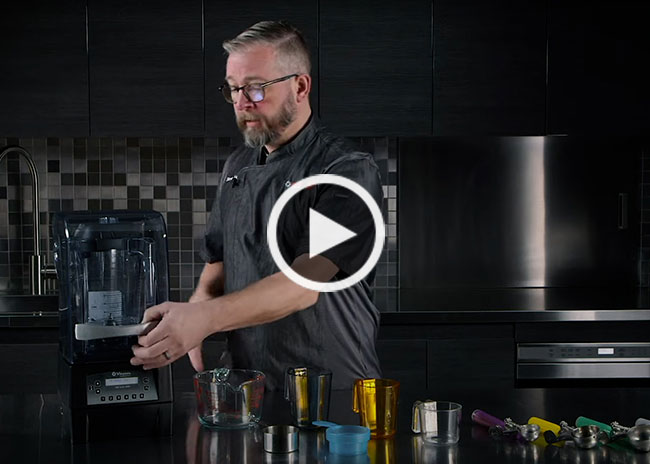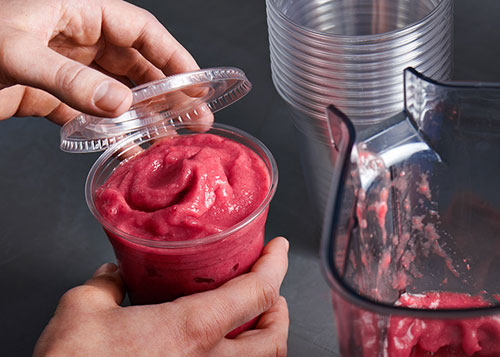 One of the best attributes of the signature beverage is that it’s the same, every time.
One of the best attributes of the signature beverage is that it’s the same, every time.
What makes your signature beverage especially desirable, so desirable that your customers return again and again to your restaurant full of expectation? Apparently, you have really hit on something – and now it is up to you to deliver on it consistently.
But, there may be times when blended signature beverages somehow miss the mark. And, it can be easy to blame current circumstances, such as turnover, long drive-thru lines, or staffing snafus.
There is another set of causes, however, related to your beverage station setup – but you can alter these and, as a result, go a long way toward safeguarding your processes, even with a less-than-ideal labor situation. At Vitamix®, we have identified four specific setup questions relating to beverage prep. Answering these will help to make beverage consistency much easier to achieve.
First, however, purchasing programmable blending equipment is imperative. For example, The Quiet One® from Vitamix Commercial is a favorite pick for many quick-service establishments because it delivers flawless results, yet offers a great deal of flexibility. Thirty-four optimized programs in The Quiet One’s memory cover the full range of blended beverages and whips, whether smoothies, cold coffee drinks, or cold foam toppings.
Any of the 34 optimized programs can be prioritized and assigned to the six one-touch buttons on the front of the machine. That makes beverage prep infinitely easier for front-of-house employees. Just press one button, and the blender completes the chosen cycle.
The Quiet One will enable you to lock in blending consistency, eliminating a lot of potential variables; yet, there are still a lot of steps that precede blending – and any of these could affect your beverage consistency. So, let’s consider the four questions related to beverage prep.
 See what goes into setting up a successful, repeatable blending program.
See what goes into setting up a successful, repeatable blending program.
- Can you simplify the measurement process? – If employees are rushing, that can lead to errors in measuring out ingredients. If the ratios of fruit to ice are off, for example, your counter staff won’t likely serve up the beverage that’s intended.
 Beverage station setup plus the use of programmable blending equipment can help safeguard processes.
Beverage station setup plus the use of programmable blending equipment can help safeguard processes.
The good news is that you may be able to protect and ensure the accuracy of measurements by equipping each store with color-coded measuring scoops, spoons, and containers that are labeled by size (small, medium, and large). Filling each device to the brim and leveling off is far more accurate – and also faster – than filling oversized measuring devices up to a certain mark. Color-coding the containers helps with speed and also aids in training.
In addition, when measuring larger quantities of solid ingredients, select containers that are narrow and deep in shape rather than wide and shallow. Narrow containers reduce mounding over the brim. With wide and shallow measuring containers, a larger mound is possible if your staff is not being careful. - Did You Right-Size the Ice? – Choose smaller forms of ice – like nuggets, pearls, or flaked ice – over larger types of ice, such as full cubes, large spheres, crescents, and half dice or full dice. While the larger cubes are great for chilling soft drinks, they do not measure out as well. They also take longer to blend.
Larger forms of ice do not pack as well into measuring cups, leaving large gaps of space. In the case of bridging (i.e., when ice cubes stick together), they may also mound over the brim of the container, leading to further inaccuracies. Using larger cubes also may affect service times, since they could take longer to process during blending.
Using small ice cubes, nuggets, and flaked ice helps to negate these issues. These more compact forms will pack more densely in measuring cups with less mounding. They’ll also be far easier and faster to process. - Are your holding temperatures within range? – Ingredient storage and holding temperatures also play an important role in beverage thickness and consistency. Holding temperatures refer to the ideal temperature of ingredients just before they’re used, as specified by the manufacturer or supplier.
Holding temperatures are important because they affect the desired thickness of a beverage and also holding times (i.e., how long a beverage maintains its thickness after being served).
To ensure ingredients are kept at optimal holding temperatures, select equipment expressly designed for this purpose. Dipping cabinets with doors that open from the top are ideal for quick-service restaurants and especially well-suited to situations where the doors are being opened and closed frequently. These types of freezers and refrigerators are better than refrigerators and freezers with doors that open to the side, which allows the cold air to spill out.
You’ll also want to account for “slacking time” when loading dipping cabinets with ingredients from long-term storage. Slacking time is the amount of time it takes for the ingredients to thaw to the holding temperature, which may be 20 to 30 degrees higher. Allowing time for this adjustment is another way to ensure that ingredients are at the right temperature before use. - Are You Loading Ingredients in the Right Order? – When blending beverages, the order in which ingredients are added to the blender container does matter. And you can greatly ensure employees are following the correct order by staging ingredients in the build station accordingly.
Organize beverage add-ins starting at the farthest point from the blender, locating additional ingredients progressively closer to the blender. To ensure efficient and thorough blending time after time, add liquid ingredients first, followed by solid ingredients.
Start with liquids, such as milk, water, and juice. Next up are powders, such as matcha and protein supplements that, without a liquid to dissolve in, could otherwise clump or stick to the sides of the blender. Third in line are leafy greens, soft vegetables, and fresh fruits, followed by frozen fruits, fibrous vegetables, and ice, which should be located closest to the blender. Adding ingredients in this order encourages heavier, denser ingredients to weigh down into lighter ones. During blending, solid ingredients will gradually be pulled into the blending vortex, where they’ll process thoroughly without requiring a tamper. You will also not need to interrupt the blending process to scrape down the sides of the container.
Your Recipe for Consistency
 Eliminate many potential variables in beverage prep by using programmable blending equipment such as The Quiet One®.
Eliminate many potential variables in beverage prep by using programmable blending equipment such as The Quiet One®.
Reviewing these four beverage prep questions should help you to set up a strategically organized build station. Then, implementing any required changes will ensure that your beverage program remains consistent, blend after blend, even with new employees and during peak rush hours. Combine these measures with The Quiet One blender and you’ll have a beverage program promising consistent results in spite of potential variables relating to circumstances, like turnover, that may be beyond your control.
Want to learn more? Reach us at This email address is being protected from spambots. You need JavaScript enabled to view it..



